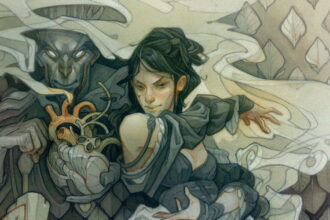Action Points Revisited – Hero & Villain Points (5e)

Back in October, I looked at three alternatives to Inspiration for D&D Fifth Edition. One of the three alternatives I looked at was Action Points (or Hero Points). This week on the Campaign Trail, I’m looking at tweaking Action Points that we have been using in my weekly game where I’m running Tomb of Annihilation in Eberron’s Xen’drik.
Like Inspiration, Action Points give players a way to affect mechanical game play, by improving important rolls. Unlike Inspiration, a player does not earn Action Points from gameplay, but is given a limited number of Action Points, beginning at first level and each time they level up. Once an Action Point is spent, it is gone for good, but they are meant to be spent as they can’t be saved up and carried over during level up. In 3.5, Action Points have even be used to gain extra uses of certain class powers.
As mentioned above, in my current campaign we’re using Action Points.We’re 13 sessions in, and I am not feeling like this rule is providing the heroic moments I was hoping they would. I really liked the idea of giving the players a resource they could use to prevail over tough challenges. What I have found is that in practice, Action Points aren’t feeling all that heroic, and seem to be a much lower reward for spell casters who require enemies to make saving throws. I decided that I would tweak action points to become Hero and Villain Points, which I outline below.
Action Points
Here is the original Action Points I was using. Pretty close to what you find in UA Eberron or the DMG’s Hero Points section.
The Eberron campaign setting introduced this concept to reflect characters who are larger-than-life heroes destined for great things. Action points allow a player to add a bonus on any d20 roll so that characters can dodge or at least mitigate the effects of bad luck.
- Each time you gain a level, you lose any unspent action points and gain a new total equal to 5 + half your level (rounded down).
- You can spend an action point whenever you roll a d20 to make an attack roll, an ability check, or a saving throw.
- You don’t have to decide until after you make the roll and learn if it succeeded or failed.
- If you spend an action point, roll a d6 and add it to your d20 result, possibly changing a failure into a success.
- You can spend only 1 action point per roll.
- In addition, whenever you fail a death saving throw, you can spend an action point to make it a success.
Hero and Villain Points
Here are my homebrew rules to replace Action Points that I’ve talking to my players about implementing for this week’s game. Hero and Villain points borrow heavily from Action Points, but add a new twist borrowed from games like FATE Core and Star Wars: Edge of Empire, where spending a hero point puts a villain points in the hands of the Gamemaster.
Hero points allow a player to “take a 20” on any d20 roll or force an enemy to “take a 1”, changing the outcome of a pivotal moment in the game.
- Each time you gain a level, you lose any unspent hero points and gain a new total equal to half your level (rounded down, minimum 1).
- A hero point must be spent before a roll is made.
- You can spend a hero point whenever you are asked to roll a d20 to make an attack roll, an ability check, or a saving throw (including death saving throws), allowing you to “take a 20”.
- You can spend a hero point whenever an enemy is required to roll a d20 to make an attack roll, an ability check, or a saving throw, forcing an enemy to “take a 1”.
- You can spend only 1 hero point per session.
- A spent hero point become a villain point that can be spent by the GM in a future encounter.
- Villain points can be spent by an enemy to “take a 20” on an attack roll, an ability check, or a saving throw.
- A GM can only spend one villain point per encounter and any unspent villain points are lost when the PCs gain a level.
- A spent hero or villain point roll should be considered natural, the same as rolling the result with a die.
From a strategy standpoint, this allows for big heroic final battles at the end of a level where players can spend hero points and not have to worry about them burning them by putting them into the hands of the enemy. That being said, if you have to burn them earlier in the level (to not die), things will get tougher as you face subbosses and BBEGs with villain points. I like the idea of a big play token versus action points which are more numerous, smaller plays meant to reduce the swingy nature of d20 rolls (especially at lower levels).
I’m a little worried about “a spent hero or villain point roll should be considered natural, the same as rolling the result with a die.“, which is an automatic critical in many cases – but would be exciting. It would also provide a 20 on a death save, which brings a PC right back up and fighting again. I may rewrite the rules to make the rolls to be non-natutrals, to allow for a roll of 20 or 1, but avoiding criticals and automatic failures.
This is still a work in progress, let us know what you think in the comments below.



